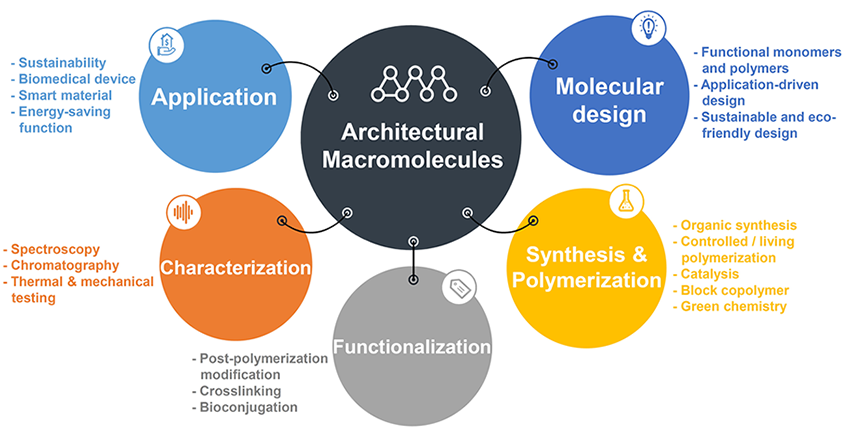Architectural Macromolecules
In Architectural Macromolecules group, we focus on exploring design, synthesis and development of novel polymeric materials to provide practical solutions to environmental problems. We leverage on our expertise in organic and polymer chemistry to create, control and examine architectural macromolecules with tailored molecular weights, morphologies and functions. The discovery of precise polymerization methods and macromolecule structure-property relationships are valuable for advancing polymeric materials for targeted applications, e.g., biomass-based polymers, close-loop recyclable polymers, stimuli responsive polymers, green polymerization and polymer upcycling.
Research Areas
Architecturally complex polymers
Unlike small molecules with singly defined structures and molecular weights, polymers consist of a number of monomer units with varied topological structures. The control of polymer composition, molecular weight and topology is the key to produce functional polymeric materials and modulate material properties. Our group is interested in the development of utilizing controlled/living polymerization techniques as the construction tool to synthesize architecturally complex polymers such as block copolymers, branched polymers, star polymers, crosslinked networks, polymer electrolytes and polymer brushes. We also use advanced characterization methods to examine sub-chain connections in such complex macromolecules to investigate the structure-property-performance relationship of the polymeric materials.
Biomass-based synthetic polymers
Using fossil fuels for energy and chemical raw materials has taken a heavy toll on the environment and society, from air and plastic pollution to global warming. Reducing fossil fuel dependence and combustion has become a top priority for global climate policy. Today, fossil fuels represent more than 99% of the plastics raw material base but the use of biomass as a feedstock for producing biomass-based plastics is gaining interest. Organic acids and alcohols generated by refining plant biomass are valuable and promising resources for the development of novel biomass-based plastics with advanced properties. Our group aims to develop key synthetic and polymerization technologies to produce sustainable plastics by using biomass as raw materials. The design and development of wide- scope biomass-based monomers and polymers, coupled with post-synthesis modification and crosslinking reactions, offer the next-generation circular plastic materials with desired properties.Stimuli-induced structure-property switchable materials
Stimuli-responsive materials are known as “smart” materials which could reversibly changes its structure/shape and properties in response to external stimuli. Stimuli-responsive biomacromolecules, such as proteins and nucleic acids, is found abundantly in nature and enable living species to show stimuli responsive behaviors such as shape or skin-color changing. Stimuli-responsive polymers have attracted great interest and applied as actuators, robotics, sensors and coating materials. We are interested in designing and synthesizing novel monomers and polymers with reversibly switchable structures and properties. Chemical structures in polymeric materials is dynamically changeable and enable to be modulated by pH, thermal, light, force or reduction-oxidation stimulus. These smart materials are able to be apply for molecule separation, sensing, functional surfaces and self-healing materials.
Capabilities
- Application-driven design and synthesis of functional monomers and well-defined polymers using organic synthesis and polymerization techniques.
- Synthesis of functional polymeric materials, including block copolymers, polymer carriers and soft materials, for biomedical, energy-efficient and coating applications.
- Development of green polymerization technology and sustainable materials.
Contact
A*STAR celebrates International Women's Day

From groundbreaking discoveries to cutting-edge research, our researchers are empowering the next generation of female science, technology, engineering and mathematics (STEM) leaders.
Get inspired by our #WomeninSTEM
.png?sfvrsn=b59474e9_3)
